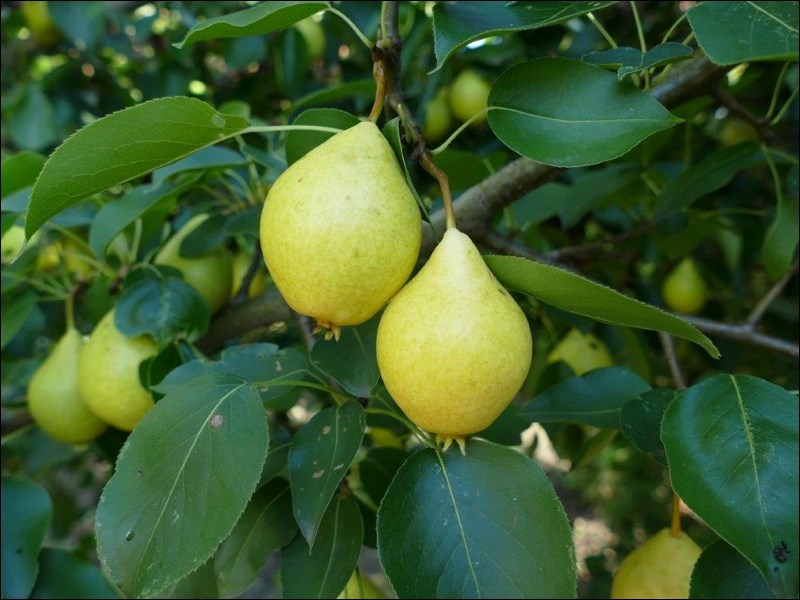Most of the pears hardy on the prairies are hybrids of the Manchurian pear (Pyrus ussuriensis) and the European pear (P. communis). Breeders have sought to combine the hardiness of the former with the fruit size and quality of the later.
Some of the earliest breeding carried out on the prairies was by Dr. Cecil Patterson, the first head of the Department of Horticulture at the University of Saskatchewan. The Apostle series of eight pears was released in 1960 just prior to his retirement. While many of these have been superseded by more recent introductions, John and Thomas remain readily available.
John has a strongly upright and pyramidal form and is ornamental. Its fruit (three by 2.5 inches) are the largest of the Apostle series, of good quality flesh and ripen in late September.
Thomas has a more spreading form and produces more fruit than John that is within easier picking range. The round fruit is 2.25 inches in diameter, of fair quality and ripen in late September or early October. The firm flesh keeps well and is good for canning.
Golden Spice from the University of Minnesota was introduced in 1949. It is productive of good tasting, small, spicy fruit but only dependably hardy to zone 4. It has shown regular winter die back in Saskatoon.
Ure, released from the Morden Research Station in 1978, has round fruit two inches in diameter that is good fresh or for processing, ripening in mid-September. It has a tendency to ripen unevenly over a few weeks while still on the tree. Hardy to zones 3 and 4, the trees experience regular dieback problems in zone 2.
Early Gold, a Ure seedling selected by Wilbert Ronald of Jeffries Nursery in 1994, is probably the best choice for zone 2. The tree is smaller than most pears, at only 30 feet. The round fruit is similar to Ure, matures earlier, is two inches in diameter and can be used fresh or for jam.
Plant pears in early spring in well-drained soil in full sun. Mulch after planting to conserve moisture and control weeds. They are usually grafted onto Manchurian pear rootstock and suckers emerging from the base should be removed. They mature to large trees, up to 40 feet in height with a 20-foot spread and should be spaced accordingly. Water regularly during their first few years. Once established, they are drought-tolerant. Apply fertilizer sparingly. Too much nitrogen makes them more vulnerable to fireblight.
Pears bloom early with beautiful white flowers with contrasting black stamens. The flowers are complete but self-incompatible. This means two trees, the Manchurian pear or another variety that blooms at the same time, are required for fruit set.
Pears are ripe when they change colour from green to yellow. Often, within a week after changing colour, they begin to rot internally. If left to ripen on the tree, they may develop stone cells that give them a texture similar to sand. It’s best to pick the fruit when it’s fully grown, but green and hard and allow them to mature off the tree. Once fully ripe, they have a very short shelf life before becoming mushy. (Ralph Waldo Emerson was only slightly exaggerating when he wrote, “There are only 10 minutes in the life of a pear when it is perfect to eat.”) Most are good for canning and pear sauce.
Fireblight is the only serious disease problem. Prune off diseased portions as soon as they are noticed, disinfecting your tools between each cut.
Sara Williams is the author and coauthor of many books including Gardening Naturally with Hugh Skinner, the revised and expanded Creating the Prairie Xeriscape and recently, with Bob Bors, Growing Fruit in Northern Gardens. She gives workshops on a wide range of gardening topics throughout the prairies.
— This column is provided courtesy of the Saskatchewan Perennial Society (SPS; [email protected] ). Check our website (www.saskperennial.ca) or Facebook page (www.facebook.com/saskperennial) for a list of upcoming gardening events. June 10 - SPS Self-guided Garden Tour; June 16 - 9 a.m. or June 19, 6:30 p.m. – SPS Labour and Learn at the Mediation and Rose Gardens, Forestry Farm Park and Zoo.
Early Gold is among the hardiest pears for prairie gardens. Photo courtesy Bylands Nurseries




